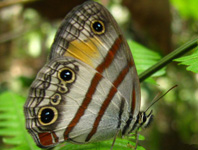Abstract
The Cretaceous asteroid Arthraster is referred to the living family Chaetasteridae on the basis of similarities in ossicular arrangement in the abactinal disc and arms. Chaetasterina, previously identified as a chaetasterid, is transferred to the family Asterinidae, subfamily Hyalothricinae, and constitutes the first fossil record of the subfamily.
References
Agassiz, L. (1836) Prodrome d’une monographie des radiares ou Echinodermes. Mémoires de la Société Scientifique de Neuchâtel, 1, 168–199.
Bell, F.J. (1894) On the Echinoderms collected during the voyage of H.M.S. Penguin and by H.M.S. Egeria, when surveying Macclesfield Bank. Proceedings of the Zoological Society of London, 1894, 392–413.
Bruzelius, N. (1805) Dissertatio sistens species cognitas asteriarum, quamr. sub praesidio A. J. Retzius exhibet N. Bruzelius. Berlingianis, Lundae, 37 pp.
Clark, A.M. & Downey, M.E. (1992) Starfishes of the Atlantic. Chapman & Hall, London, New York, Tokyo, Melbourne and Madras, 794 pp., pls. 1–118.
Fisher, W.K. (1911) Hyalinothrix, a new genus of starfishes from the Hawaiian Islands. Proceedings of the United States National Museum, 39, 659–664, pls. 69–71.
https://doi.org/10.5479/si.00963801.39-1807.659
Fisher, W.K. (1913) New starfishes from the Phillippine Islands, Celebes and the Moluccas. Proceedings of the United States National Museum, 46, 201–224.
https://doi.org/10.5479/si.00963801.46-2022.201
Forbes, E. (1848) On the Asteriadae found fossil in British strata. Memoirs of the Geological Survey of Great Britain, and of the Museum of Practical Geology in London, 2, 457–482.
Forbes, E. (1850). Description of the fossils of the Chalk Formation. In: Dixon, F. (Ed.), The geology and fossils of the Tertiary and Cretaceous formations of Sussex. Longman, Brown, Green & Longmans, London, pp. 325–343.
Gale, A.S. (1987) The Phylogeny and Classification of the Asteroidea. Zoological Journal of the Linnean Society, 87, 107–132.
https://doi.org/10.1111/j.1096-3642.1987.tb00652.x
Gray, J.E. (1840) A synopsis of the genera and species of the Class Hypostoma (Asterias, Linnaeus). Annals and Magazine of Natural History, 6, 275–290.
https://doi.org/10.1080/03745484009443296
Hess, H. (1970) Schlangensterne and Seesterne aus dem oberen Hauterivian “Pierre Jaune” von St-Blaise bei Neuchâtel. Eclogae geologiae Helvetica, 63, 1069–1091.
Jangoux, M. (1984) astérides littoraux de Nouvelle-Calédonie. Bulletin du Muséum national d’Histoire naturelle, Series 4, 6A (Zoologie, Biologie et Ecologie animale), 2, 279–293.
Koehler, R. (1910) An account of the shallow-water Asteroidea. Echinoderma of the Indian Museum. Part 6. Trustees of the Indian Museum, Calcutta, 192 pp.
Mah, C.L. (2020) World Asteroidea Database. Chaetaster nodosus Perrier, 1875. Accessed through: World Register of Marine Species. Available from: http://www.marinespecies.org/aphia.php?p=taxdetails&id=177902 (accessed 25 May 2020)
Mah, C.L. & Fujita, T. (2020) New species and occurrences of Japanese Solasteridae and Ganeriidae including a new species of Paralophaster from the Pacific with an overview of Hyalinothrix. Zootaxa, 4750 (1), 67–100.
https://doi.org/10.11646/zootaxa.4750.1.4
Müller, J. & Troschel, F.H. (1842) System der Asteriden. Papier, Druck und Verlag, von Friedrich Vieweg und sohn. Braunschweig, XX + 134 pp., 12 pls.
Perrier, E. (1875) Révision de la collection de stellérides du Museum d’Histoire naturelle de Paris. Reinwald, Paris, 384 pp.
Schöndorf, F. (1909) Die Asteriden des russischen Karbon. Palaeontographica, 45, 323–388, pls 23 + 24.
Sladen W.P. (1889) The Asteroidea. Report of the scientific results of the voyage of H.M.S. Challenger, Zoology, 30, 1–935, pls. 1–118.
Spencer, W.K. (1907) A monograph of the British fossil Echinodermata from the Cretaceous formations. Vol. 2. The Asteroidea and Ophiuroidea. Monograph of the Palaeontographical Society, 4, 91–132.
https://doi.org/10.1080/02693445.1907.12035532
Spencer, W.K. (1913) The evolution of the Cretaceous Asteroidea. Philosophical Transactions of the Royal Society of London, Series B, 204, 99–177.
https://doi.org/10.1098/rstb.1914.0004
Spencer, W.K. (1918) A monograph of the British Palaeozoic Asterozoa. Monograph of the Palaeontographical Society, Part 3, pp. 109–168, pls. 6–13.
https://doi.org/10.1080/02693445.1918.12088367
Spencer, W.K. & Wright, C.W. (1966) Asterozoans. In: Moore, R.C. (Ed.), Treatise on Invertebrate Paleontology. Part U. Echinodermata 3(1). Geological Society of America and University of Kansas Press, Lawrence, Kansas, pp. U4–U107.
Verrill, A.E. (1870) Notes on the Radiata in the Museum of Yale College. 1. Descriptions of new starfishes from New Zealand. 2. Notice on the echinoderms of Panama and the West coast of America. 3. On the geographical distribution of echinoderms of the Pacific coast of America. Transactions of the Connecticut Academy of Arts and Science, 1–3, 247–251, 251–322 & 323–351.


